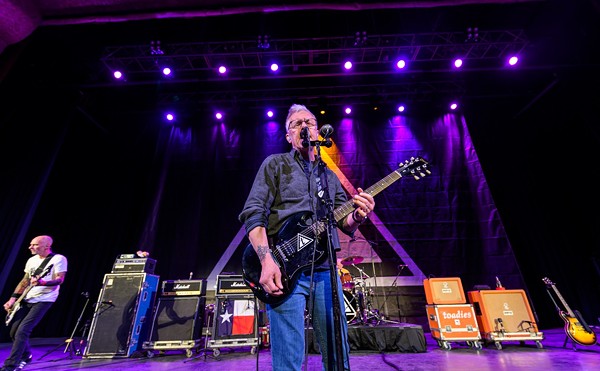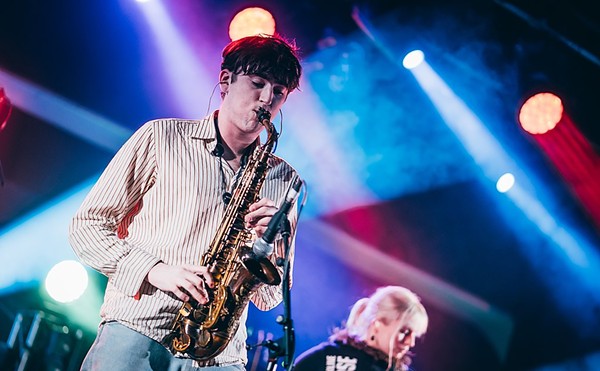From the Archives: Selena: A Star Dies And An Icon Is Born
By Bill Ramsey on Tue, Mar 31, 2015 at 8:38 am
Page 2 of 2
What endured Selena — and elevated her in death to near sainthood — to most everyone she came in contact with, from neighbors to strangers, fans, musicians, and media types, was an incomparable radiance. She was, to speak with people who knew her well and those who had barely knew her, perhaps one of the nicest people to walk the face of the earth. “I remember when I would call her up early in the morning as part of a prank,” recalls disk jockey Johnny Ramirez of top local Tejano radio station KXTN-FM, “and she would always be in a good mood. She had this great laugh — even if something she said wasn’t that funny, you found yourself laughing along with her.” As for the fanatical devotion of her fans, Ramirez recites another familiar quality repeated by those who knew her: “She was us,” he says, speaking of the second, third, and fourth-generation of Mexican-Americans he calls Tejanos. “A child of Mexican-American parents who grew up listening to American music but still loving her own culture.”
Selena had also defined the word “crossover.” Like a lot of Tejanos, Ramirez says, Selena had to go back to reacquaint herself with her culture. “She had to go back and relearn Spanish and rediscover her culture. Like a lot of us, she had put it on the backburner.” Selena did so with a zest. As Ramirez and others attest, her first few brushes with the Spanish-speaking press were near disasters. “In one of her early interviews, her Spanish was quite bad,” says Ramirez. “In one of her last, it was eloquent. That was the kind of person she was. She worked as hard off stage — in the way she led her life, her family values, and the fact she wanted to get back to her culture — as she did onstage.”
But her appeal had more than language at its core.
“She was not just a Latin Star, she was an American star, the first person many Latina girls had to look up to,” says the Boston Globe’s Valdes. “She wasn’t a victim, like in the novellas, she was a gutsy, confident, happy woman.”
“The hero worship is understandable,” says San Antonio Express-News columnist Carlos Guerra. “A lot of people feel that they knew her personally. For as young as she was, she had been performing for a long time. When I was in Corpus [Christi] recently, I ran into three different people who said they had met her in Wal-Mart and Target. She was that accessible.”
People identified with Selena in another way as well, says Guerra: “She was making it, and about to make it in other markets. That was just real obvious. There are huge cultural differences not only between the crossover from the Tejano market over to the English-language market, but between Tejanos and the Mexican-American people in California and Florida. In California, the music is much more ‘she-boop, she-boop.’ She crossed over that. In Miami, where the population is Cuban, she was the lead act at the Calle Oche festival and she crossed over, she knocked ‘em out.”
As if to underscore her phenomenal impact, the legend of Selena will enter the canon of academia next year as part of the music segment of Dr. Candia’s course.
“Her crossover is very, very real,” says Candia. “It’s more than just music, it’s about acceptance of the culture, that it is part of mainstream America. Just as it is to blacks, it’s very important [for Mexican-Americans] to be considered part of Americana.”
In a recent New York Times Magazine cover story titled “ELVIS, HEALER,” a photograph of the Vegas-era rock ‘n’ roll god is framed in an arch, laced with flowers as a dozen candles burn at an altar. “He had fans. Now he has followers,” reads the subtitle. What was once rock-and-roll has become a redemptive faith.”
The article details the author’s pilgrimage to Memphis, Tennessee, to experience first-hand the religion of Elvis Presley as it unfurls during “Death Week” ceremonies each August. What writer Ron Rosenbaum found in the heart of Elvis Country — a coveted American folk ritual born of a longing for spirituality and a lust for celebrity worship- was that in death, Presley had “transcended the camp ridicule, the kitschy condescension, the hostile tell-all bios,” and that “The pilgrimage to Graceland had become a way for all kinds of Americans to come to terms with all kinds of pain and loss.”
The similarities between the King of Rock ‘n’ Roll and the Queen of Tejano are as obvious as they are strikingly different. As many Americans deify Elvis, evoking a Jesus-like figure whose suffering gave birth to a culture seeking redemption, Selena is seen by many as a symbol of hope and a beacon of a brighter future for all who heed her example. Unlike the cult of Elvis, the cult of Selena exposes a great cultural divide. In death, says columnist Guerra, Selena gave a face “to a people that nationally didn’t exist before.”
The altars and shrines, the pilgrimages to her home and graveside, the religious aura surrounding Selena are, says KXTN’s Ramirez, a natural part of Mexican-American culture. “The religious connotation is appropriate,” adds reporter Valdes. “Culturally, dealing with the death of people involves idol worship.”
“The music speaks for itself,” says Joe Nick Patoski, senior editor at Texas Monthly and author of a forthcoming biography of Selena. “There’s no doubt she took Tejano to a higher level. As far as her legend growing after her death, consider the culture. There are not many role models if you’re Mexican-American, particularly if you’re a young Latin female, they’re few and far between.” The enormous interest in Selena, both in the Latin world and mainstream America, says Patoski, is predicted on the circumstance of her death. “You’ve got a lot of James Dean and Buddy Holly aspects,” he adds. Moreover, when you put the Latin aspect to it, it becomes far more compelling than the loss of any American rock ‘n’ roll hero. All those events were tragic, but tell me one more tragic than dying at the hands of your number one fan.”
“Her legacy,” adds KXTN’s Ramirez, “is going to be that of a very talented individual who, for a brief instant, gave us something to look up to. This is what you can be if you study and work hard enough. If people continue to use her like that, her music is going to be around forever. We can use her, hopefully, to bring up the future of America, our kids. The sad part is, of course, that she was taken just as her rocket was about to take off.”
The cult of Selena, says Patoski, has no end. “Set the music aside, and look at some of the other South Texas saint and see how long they’ve lasted. This can go on for at least as long as the people living today, and will quite likely be an inspiration for generations to come.”
On a warm, sunny October afternoon not much different from the Spring day of Selena’s funeral seven months before, several hundred people gathered on a cordoned-off street on the banks of the San Antonio River. In front of the Hard Rock Cafe, where Selena had performed in January, the faithful and the curious and the media milled, awaiting the latest offering at the altar of the church of Selena. There, the father, the husband, and the Holy Ghost gathered to emboss her name on a star that would both inaugurate the cafe’s “Walk of Fame” and correct the indignity of having been denied a similar tribute in Hollywood.
“Her exhibit replaced the Elvis exhibit,” says columnist Guerra, leaving little doubt as to Selena’s significance.
“Emilio’s replaced Frank Sinatra’s,” he adds with a sly laugh. “It’s telling, isn’t it.”
Originally published November 2, 1995
Tags:

KEEP SA CURRENT!
Since 1986, the SA Current has served as the free, independent voice of San Antonio, and we want to keep it that way.
Becoming an SA Current Supporter for as little as $5 a month allows us to continue offering readers access to our coverage of local news, food, nightlife, events, and culture with no paywalls.
Scroll to read more Music Stories & Interviews articles
Newsletters
Join SA Current Newsletters
Subscribe now to get the latest news delivered right to your inbox.

















